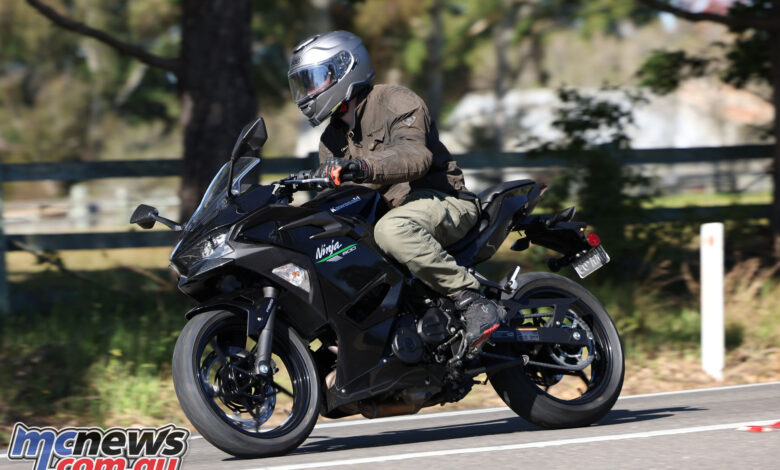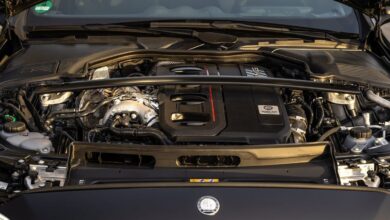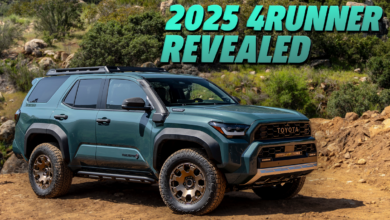2024 Kawasaki Ninja 500 Review | Motorcycle Test

2024 Kawasaki Ninja 500 Motorcycle Review
Test by Kris Hodgson, Images Linda Read
Kawasaki’s Ninja 400 has been a powerhouse right from its introduction to the Australian market. Before the 400 arrived, the 300 and 250 models dominated this segment of the market. The latest iteration is now hitting the big ‘500’ in terms of capacity, even if it is really only 451 cc.

Back in the day, Kawasaki and Yamaha had a bit of back and forth in the capacity wars, with the Ninja 300 breaking out of the 250 cc category. Yamaha answered with the R3 at 321 cc. Then Kawasaki launched the 400 and pretty much gazumped everyone for a while.
For the Ninja 500, Kawasaki obviously figured the existing machine was a strong enough offering to return with relatively minor tweaks, apart from the new and larger engine, which significantly boosts torque. That’s almost an extra six Nm, peaking 2000 rpm earlier, and it is a change that is immediately noticeable if you’ve spent time on the Ninja 400. Which I have, having owned one from 2019 through to early 2024.

It’s also worth noting we seem to be receiving the EU version of the 500, which offers 33.4 kW peak power. But there’s an unrestricted version that produces 38 kW and actually boasts a power boost over the 400, which was quoted at 35 kW here in Australia. So it’s pretty doubtful the 38 kW version would be LAMS compliant, which is maybe why we aren’t getting it.

The 2024 Ninja 500 will also come in a SE version at a later date, which adds some more modern features, like a TFT display, keyless ignition, LED indicators, USB-C outlet, and it looks like it will also get frame sliders, a seat cowl, a radiator screen, and a few other extras.
On the other hand, the base Ninja 500 just runs the larger engine, has restyled bodywork – which I do reckon looks amazing – and tweaked suspension. There’s smartphone connectivity, too, but just an LCD dash.

The clutch is updated with spring rates and plate material revised, and I reckon it’s a little heavier than on the 400, but still easily lightest in its class. This should put some of the complaints about the previous clutch to rest, although I’d never experienced them.
Pricing for both the Ninja 400 and Ninja 500 is actually exactly the same in 2024, just a smidge over $9K ride-away in Sydney.

What made the 400 such an exceptional beginner machine carries over to the Ninja 500, because if it ain’t broke don’t ‘fix’ it, and the 785 mm seat height is incredibly welcoming to the vast majority of riders.
Raised ‘bars give you a sporty but relaxed seat position. Think more sports-tourer than pure supersport, which keeps you sitting more upright. That ensures you’re not overly committed to the seating position, which is what makes full supersport machines much easier to drop or crash at low speeds for inexperienced riders.

You’ll definitely be leant forward a little towards the controls, a little more aggressively than on a nakedbike, like the Z500, but I’d have said if you were picking between the Ninja and Z you could pretty safely just go for what you feel looks best.
The seat to ‘peg ratio still is fairly sporty, but I’m on the longer-legged side for my 180 cm, and have never had an issue with feeling cramped.

There’s a decent amount of wind protection too, thanks to the fairing, and with that super-light clutch it makes the bike very forgiving for a new rider, while also being quite hard to stall, which is often the big fear of newbies. It’s not impossible, but this is a very easy bike to start on, and will offer plenty of confidence.
Part of that confidence is the weight. The Ninja 500 is still nice and light, at just over 170 kg fuelled. Not the lightest in the class, but very close.

While Kawasaki has kept things simple, with telescopic forks and a monoshock with just preload adjustability, the handling and ride have always been a standout and that remains largely true on the Ninja 500.
At 75 kg, I felt like the rear shock was a little harsher than on the 400, but the complaints normally emerge when the NSW roads get their goat-track on, and that’s all at the rear where we’ve got that preload adjustment available to help you out there.

The 500 is also as happy cutting through traffic as it is razoring through the twisties, with easy-going handling, and the standard GPR300 tyres are good all-weather commuters. Not the stickiest, but great for longevity and general use.
In the twisties, that easy handling ensures all your focus can be on where you’re going, your eyeline and body position, and there’s good stability while leant over. Granted, I’ve spent a lot of time on the 400, so I instantly felt right at home on the 500.

Brakes are a single 310 mm front rotor with dual-piston caliper, and I’ve always been really happy with this setup. Some of the four-pot setups on the competition can be a overly bitey, and this brake setup is a little less aggressive, which I honestly prefer.
It offers very good feel and modulation, which will suit newer, less experienced riders, and is backed up by ABS.

Having recently tested the Z500 and Eliminator, which run the same engine, I’d already noticed vibes from the new engine, more noticeably on the Z than the new cruiser. `
So, on the bright side, there’s significantly more torque, and a much more taut feel to power delivery, where you really feel you’re in the meat of that torque for much longer. Fuelling is still great, and off-throttle onto engine braking is smoother.

That does mean the bike doesn’t fall into a comfortable cruising rev range at 110-120 km/h, as you’re still right among the torque, but that’s a small complaint.
This bike had less than a thousand kilometres on the clock when I picked it up, but the vibrations from the mid-range – around 5000 rpm – were quite annoying, and at times extended to the pegs, and could even be felt quite noticeably through the seat and tank.

It was also a particularly buzzy, high-frequency vibration, high frequency. The old 400 was super-smooth, and I always thought it was an amazing sport-tourer, because you could sit at highway speeds and vibes were never an issue. For longer highway stints, I always picked my Ninja 400 over a 401 for that very reason.

The new 500 now gives away that smoothness, and will actually come out second-best to the new 400 single-cylinder competition, who’ve picked up their game on the vibes front.
Kawasaki do mention a newly-designed balancer shaft in the engine updates, but honestly, the 500 feels like a step backwards when it comes to vibrations.

Unlike the Z500, where revving the bike harder made those vibes disappear, the Ninja 500 seemed to be stuck with them for a much broader section of the mid to upper rev range.
Sensitivity to vibes and what riders will personally put up with does obviously vary enormously between riders, but this did really surprise me.

What didn’t surprise me was that the seat is pretty uncomfortable, the same as on my 400. A pair of touring pants helps there, or if you’re really having a go through the twisties and moving around a lot, you won’t even notice it. For commuting or long highway stretches it’s not great, but that might be just a reflection of me being fairly bony in that region.
The vibes and seat are really my only complaints, though. The vibrations are new for the 500, and apparently the the price of all that extra torque.

To me, apart from the new styling which is backed up by great paintwork, the Ninja 500 feels more like a sideways-grade than an actual upgrade, which is probably reflected in the pricing being unchanged.
The Ninja 400 is a great bike, and the Ninja 500 offers a bit of a step up with the extra torque. But was it truly necessary? Is it worth the vibrations? Hard to say.

I will say that the more analogue approach, without all the new generation rider aids, and fancier features like USD forks, doesn’t stop the Ninja from being a great bike.
For more information check out the Kawasaki Motor Australia website (link).
I like the Ninja 500 because:
- It’s a seriously good beginner machine.
- Much better than the spec sheet would suggest…
- Eye catching styling.
I would like the Ninja 500 more if…
- The vibes were fixed.
- A more comfortable seat.

2024 Kawasaki Ninja 500 Specifications
| 2024 Kawasaki Ninja 500 Specifications | |
| Engine | Liquid-cooled, 4-stroke Parallel Twin |
| Valve system | DOHC, 8 valves |
| Bore x Stroke | 70.0 x 58.6 mm |
| Displacement | 451 cc |
| Compression ratio | 11.3:1 |
| Fuel supply | Fuel injection: ø32 mm x 2 |
| Lubrication system | Forced lubrication, wet sump |
| Starting system | Electric |
| Ignition system | Digital |
| Max. power | 33.4 kW [45 PS] @ 9000 rpm |
| Max. torque | 42.6 N·m [4.3 kgƒ·m] @ 6000 rpm |
| Driving system | Chain |
| Transmission | 6-speed, return |
| Gear ratios: 1-6 Primary/Final |
2.056 (37/18), 1.619 (34/21), 1.333 (32/24), 1.154 (30/26), 1.037 (28/27), 2.029 (69/34) 2.929 (41/14) / 3.017 (43/14) |
| Clutch type (Primary) | Wet multi-disc, manual |
| Frame | Trellis, high-tensile steel |
| Suspension | ø41 mm telescopic fork, Bottom-Link Uni-Trak, gas-charged shock with adjustable preload |
| Wheel travel | 120 mm\130 mm |
| Caster (Rake angle) | 24.5º |
| Trail | 92 mm |
| Steering angle | 35º |
| Tyres | 110/70R17M/C 54H / 150/60R17M/C 66H |
| Brakes | F: Semi-floating ø310 mm disc, dual-piston caliper, R: ø220 mm disc, dual-piston |
| Overall length | 1995 mm |
| Overall width | 730 mm |
| Overall height | 1180 mm |
| Wheelbase | 1375 mm |
| Road clearance | 145 mm |
| Seat height | 785 mm |
| Curb mass | 173 kg |
| Fuel tank capacity | 14 litre |




